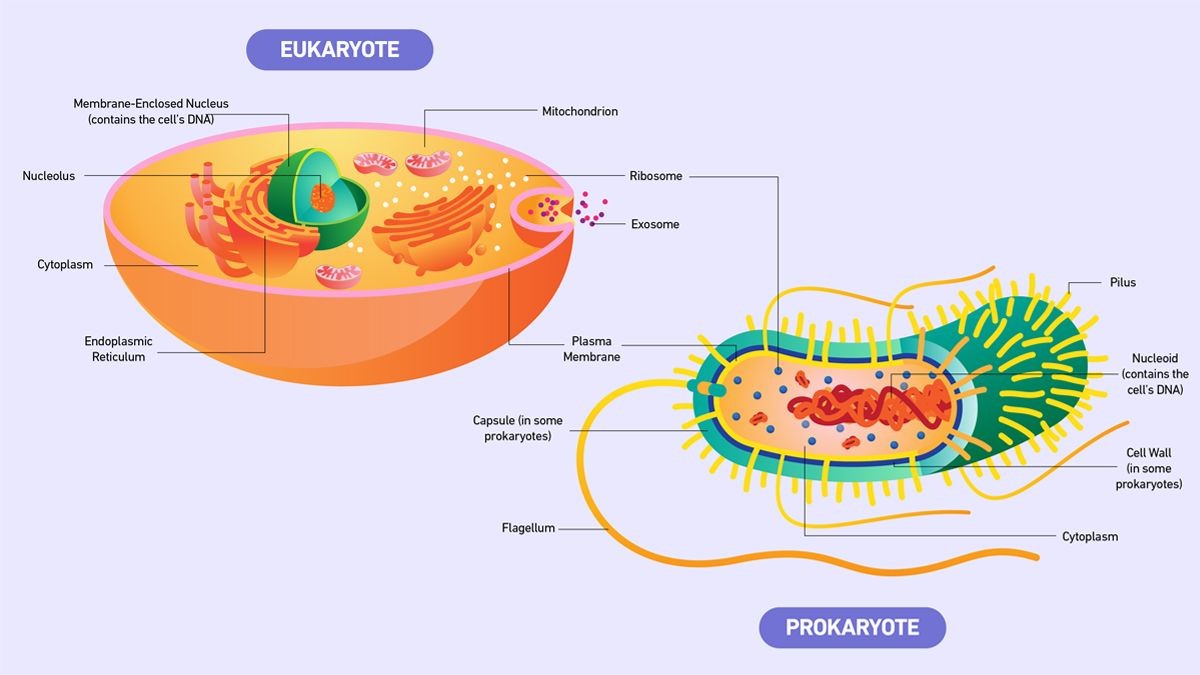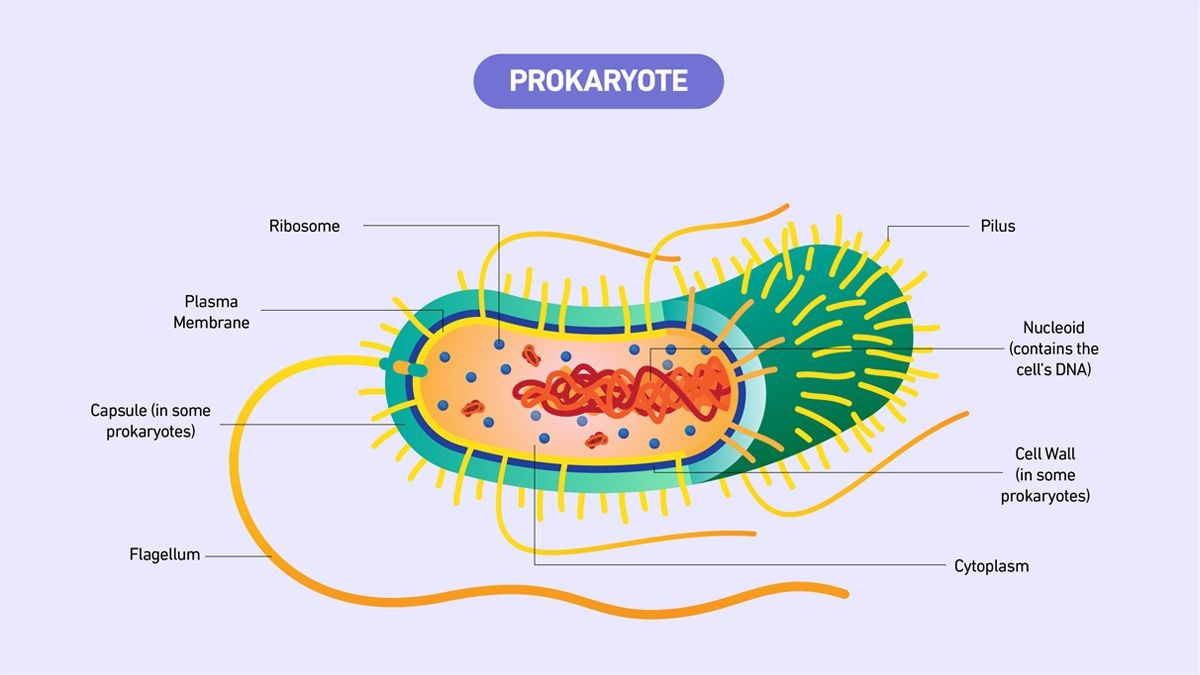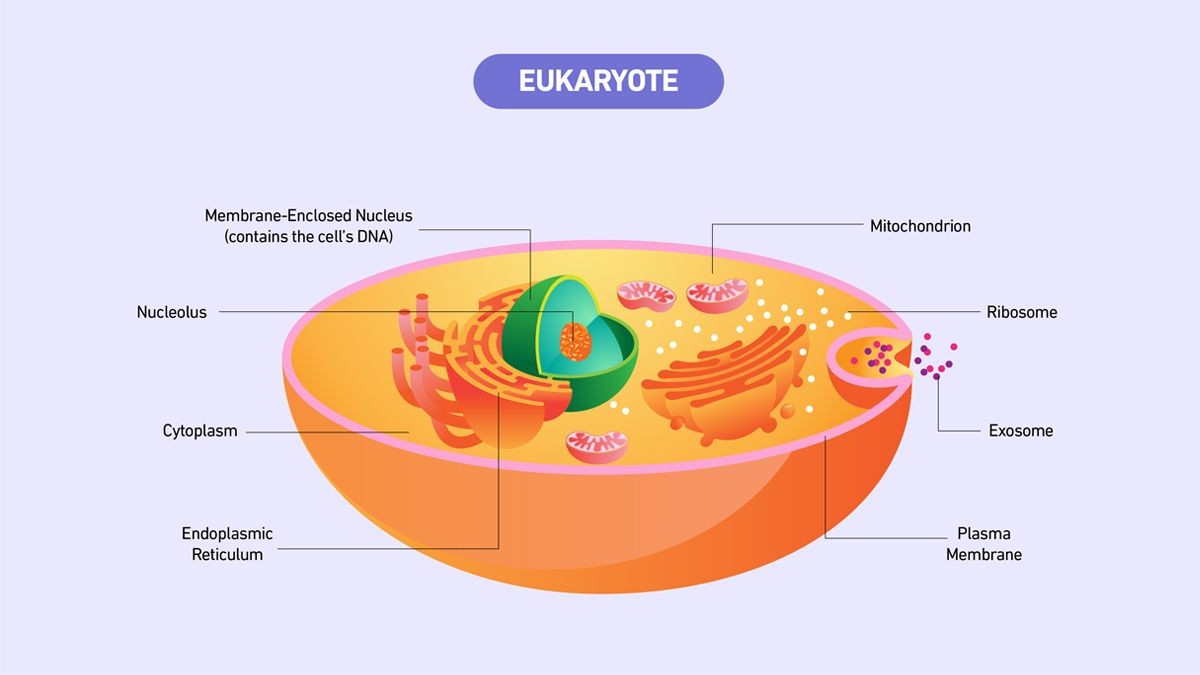Are you curious about the microscopic world and need free answers? WHAT.EDU.VN is here to help demystify the complexities of cellular biology, starting with What Is A Prokaryote. This guide explores the characteristics of prokaryotic cells and contrasts them with their eukaryotic counterparts. Discover the fundamental differences between these two types of cells, their functions, and their significance in the biological world, all while understanding their cellular components and genetic material.
1. Comparing Prokaryotes and Eukaryotes
Prokaryotes are believed to be the earliest form of life, with eukaryotes evolving from them approximately 2.7 billion years ago. The prevailing theory suggests that eukaryotes emerged from a symbiotic relationship between two prokaryotic cells, a process known as endosymbiosis. This merging is thought to have led to the development of membrane-bound organelles like mitochondria. These organelles provided eukaryotic ancestors with the necessary energy to evolve into the complex cells we see today.
However, recent research challenges this theory, highlighting prokaryotic bacteria capable of “eating” other cells, a process called endocytosis. This finding suggests that the ability to engulf cells isn’t exclusive to eukaryotes, prompting a re-evaluation of eukaryote origins.
The key difference between prokaryotes and eukaryotes lies in the presence of a nucleus. Eukaryotic cells possess a membrane-bound nucleus that houses their genetic material. In contrast, prokaryotic cells lack a nucleus; their DNA is located in a nucleoid region without a surrounding membrane. Eukaryotes also boast other membrane-bound organelles, which are absent in prokaryotes. Furthermore, the structure and location of DNA differ between these cell types. Eukaryotes have multiple molecules of linear, double-stranded DNA within the nucleus, whereas prokaryotes typically have a single, circular, double-stranded DNA molecule in the cytoplasm. Some prokaryotes, however, have linear plasmids and chromosomes.
2. Key Similarities Between Prokaryotes and Eukaryotes
Despite their differences, prokaryotic and eukaryotic cells share fundamental characteristics.
All cells, regardless of type, possess the following features:
- DNA: The genetic material that carries the instructions for cell function.
- Plasma Membrane: A cell membrane that encloses the cell, separating its internal environment from the outside world.
- Cytoplasm: The gel-like substance filling the cell, containing various cellular components.
- Ribosomes: Structures responsible for protein synthesis.
3. What Are the Key Differences Between Prokaryotes and Eukaryotes?
Prokaryotes and eukaryotes differ significantly in structure and function. These variations include the presence or absence of a nucleus and membrane-bound organelles.
Table 1: Differences Between Prokaryotes and Eukaryotes
| Prokaryote | Eukaryote | |
|---|---|---|
| Nucleus | Absent | Present |
| Membrane-Bound Organelles | Absent | Present |
| Cell Structure | Unicellular | Mostly multicellular; some unicellular |
| Cell Size | Typically smaller (0.1–5 μm), although a larger bacterium has been discovered recently. | Larger (10–100 μm) |
| Complexity | Simpler | More complex |
| DNA Form | Often circular; some have linear plasmids and chromosomes | Linear |
| Examples | Bacteria, archaea | Animals, plants, fungi, protists |




3.1 Transcription and Translation in Prokaryotes vs Eukaryotes
In prokaryotic cells, transcription and translation are coupled. Translation begins during mRNA synthesis. In eukaryotic cells, transcription occurs in the nucleus and translation happens in the cytoplasm after the mRNA exits the nucleus, meaning the processes are not coupled.
4. Prokaryote Definition
Prokaryotes are unicellular organisms lacking membrane-bound structures, divided into two domains: bacteria and archaea. Prokaryotic cells are typically small and simple, ranging from 0.1 to 5 μm in diameter.
Although prokaryotic cells lack membrane-bound organelles, they have distinct cellular regions. DNA is bundled in a region called the nucleoid. Molecules of protein, DNA, and metabolites are found together in the cytoplasm. Primitive organelles in bacteria act as micro-compartments, providing some organization.
4.1 Prokaryotic Cell Features
The primary components of a prokaryotic bacterial cell include:
- Nucleoid: The central region containing the cell’s DNA.
- Ribosome: Responsible for protein synthesis.
- Cell Wall: Provides structure and protection from the external environment. Most bacteria have a rigid cell wall made of peptidoglycans.
- Cell Membrane: Also known as the plasma membrane, separates the cell from its surroundings.
- Capsule: A carbohydrate layer surrounding the cell wall, aiding in surface attachment and protection from harmful substances.
- Pili: Rod-shaped structures involved in attachment and DNA transfer. Also referred to as fimbriae.
- Flagella: Thin, tail-like structures facilitating movement.
4.2 Examples of Prokaryotes
Bacteria and archaea are the two main types of prokaryotes. Bacteria are incredibly diverse and can be found in various environments, including soil, water, and even inside other organisms. Archaea, often found in extreme environments like hot springs and salt lakes, are known for their resilience.
4.3 Do Prokaryotes Have a Nucleus?
Prokaryotes lack a nucleus. Instead, their DNA is bundled in a central region called the nucleoid. Prokaryote DNA usually exists as a single circular chromosome. These organisms also lack other membrane-bound structures, such as the endoplasmic reticulum.
4.4 Do Prokaryotes Have Mitochondria?
Prokaryotes do not possess mitochondria, which are exclusive to eukaryotic cells. Similarly, they lack other membrane-bound organelles like the nucleus and the Golgi apparatus.
5. Eukaryote Definition
Eukaryotes are organisms with cells containing a nucleus and other organelles enclosed by a plasma membrane. Organelles are internal structures that carry out various functions, such as energy production and protein synthesis.
Eukaryotic cells are large (around 10–100 μm) and complex. Most eukaryotes are multicellular, but some are unicellular.
5.1 Eukaryotic Cell Features
Within a eukaryotic cell, each membrane-bound structure performs specific functions. The primary components of eukaryotic cells include:
- Nucleus: Stores genetic information in the form of chromatin.
- Nucleolus: Located inside the nucleus, responsible for ribosomal RNA production.
- Plasma Membrane: A phospholipid bilayer surrounding the cell and enclosing the organelles.
- Cytoskeleton: A network of protein fibers providing shape and aiding in organelle positioning.
- Cell Wall: Found in certain eukaryotes like plant cells, offering structural support and protection.
- Ribosomes: Responsible for protein synthesis.
- Mitochondria: The powerhouses of the cell, responsible for energy production.
- Cytoplasmic Space: The region between the nuclear envelope and plasma membrane.
- Cytoplasm: The total inner-cellular volume, excluding the nucleus, including the cytosol and all organelles.
- Cytosol: A gel-like substance comprising all material in the cytoplasm, excluding the contents of membrane-bound organelles.
- Endoplasmic Reticulum: An organelle dedicated to protein maturation and transportation.
- Vesicles and Vacuoles: Membrane-bound sacs involved in transportation and storage.
Other common organelles in many eukaryotes include the Golgi apparatus, chloroplasts, and lysosomes.
5.2 Examples of Eukaryotes
Animals, plants, fungi, algae, and protozoans are all eukaryotes.
FAQ: Understanding Prokaryotes
| Question | Answer |
|---|---|
| What is the main difference between prokaryotic and eukaryotic cells? | The presence or absence of a nucleus. Eukaryotic cells have a nucleus; prokaryotic cells do not. |
| What are the two domains of prokaryotes? | Bacteria and archaea. |
| Do prokaryotes have membrane-bound organelles? | No, prokaryotes lack membrane-bound organelles such as mitochondria and endoplasmic reticulum. |
| Where is the DNA located in a prokaryotic cell? | In the nucleoid region, a central area of the cell without a surrounding membrane. |
| What is the typical size range of prokaryotic cells? | 0.1–5 μm in diameter, making them smaller than most eukaryotic cells. |
| What are the key structures found in a prokaryotic cell? | Nucleoid, ribosomes, cell wall, cell membrane, capsule, pili, and flagella. |
| What is the function of the cell wall in prokaryotes? | Provides structure and protection from the outside environment, often made of peptidoglycans. |
| What role do ribosomes play in prokaryotic cells? | Ribosomes are responsible for protein synthesis, translating genetic code into proteins. |
| What are some examples of prokaryotes? | Escherichia coli (E. coli), Bacillus subtilis, and Halobacterium salinarum (an archaeon). |
| How do prokaryotes reproduce? | Primarily through binary fission, a simple cell division process. |
Do you have more questions about prokaryotes, cell biology, or any other topic? Don’t hesitate to ask! At WHAT.EDU.VN, we provide free and quick answers to satisfy your curiosity. Our platform is designed to connect you with knowledgeable experts ready to help you understand the world around you.
Have More Questions? Ask Away at WHAT.EDU.VN!
Finding answers to your questions shouldn’t be a struggle. At WHAT.EDU.VN, we understand the challenges of accessing quick, reliable information. Are you tired of endless searches and costly consultations? We offer a free platform where you can ask any question and receive prompt, accurate responses from knowledgeable individuals.
Address: 888 Question City Plaza, Seattle, WA 98101, United States
WhatsApp: +1 (206) 555-7890
Website: WHAT.EDU.VN
Don’t let your curiosity wait. Visit what.edu.vn today and experience the ease of finding the answers you need, all for free. Let us help you explore the world, one question at a time!

